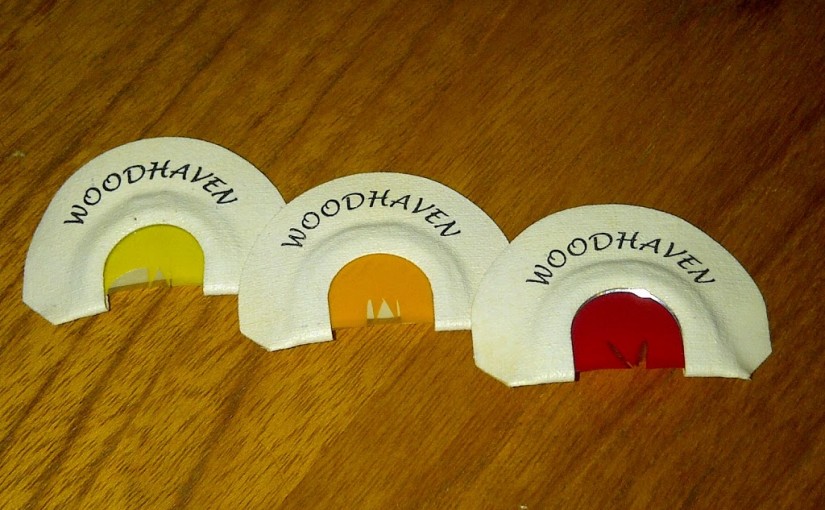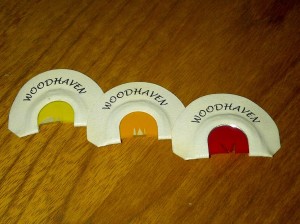On newsstands, the “big mags” are soon to be publishing their turkey hunting run-ups, and that is fine. Great actually, because I love to read them. At various times of the year, every hunting publication that you’d buy in a bookstore has what I call their “Get Ready!” issue and they all feature articles with catchy tag lines like “Fool Wary Late-Season Geese!” or “Sure Fire Tactics for Greenheads!” or my personal favourite “Your Best Rut Ever!”…like I’ve ever had a ‘bad’ rut. That’s as redundant as “good orgasm”.
These articles and features do become formulaic after a time…after all how many different times can we be told how to call to a hung up gobbler? Deer will always be deer and I think by now I know how to use rattling horns. Likewise there are not a lot of differing ‘strategies’ for deploying a pop-up blind or a trail camera. But again, that’s fine because every once in a while I find a hidden gem of wisdom. For example, last year in either Field & Stream or Outdoor Life (I can’t frankly recall which, and my wife has since recycled the magazine) there was a nifty piece about how to make a ‘wingbone’ style of turkey call out of a pen and a spent shotgun shell.
How very MacGyver.
But that’s not the point of this post. This post is about what has been missing. For all the promise, exceptional photography, and flashy splendor of these institutions, they’re missing out on what I would call the ‘unspoken fundamentals’, which I consider the basis for making any hunt enjoyable and the key skills to becoming a successful hunter. So with that in mind, I humbly submit to you a list of some of the lesser known aptitudes that truly define what makes “a hunter”.
Lying
Now this is admittedly a cliché, and we’ve all seen the shirts and hunting camp placards that say something like “Liars and Hunters Gather Here” or some permutation thereof, but in every joke there is a kernel of truth, and hunters are exceptional liars. Now I alluded to this in an earlier post, but that dealt with a certain segment of the hunting community. To put it simply, to hunt you must develop the ability to lie. Now I’m not talking about the kind of double speak and manipulation that politicians and power-brokers use. No, no…in this respect I’m referring to both the benign, passive lies that make you seem like less of an abject failure or the broad, open lies that grease the wheels of conversation. If you meet a hunter that tells only the truth, beware. He or she is not to be trusted as they are either a far too upstanding citizen to associate with, or they are a hunter par excellence and has never had any reason to lie because they always experience glowing success. Either way, those are people that you do not want to live in a cramped shack with for a week.
Excuse Making
Of the same vein, but distinct from, lying is excuse-making. To be a successful hunter this is a must-have skill and once developed it will carry you far. It has a multi-faceted range of applications from practical use in getting out of doing dishes and sweeping floors through to actually helping you harvest game. Don’t believe me? I would argue that we all know someone who through excuse-making and laziness (laziness being excuse-making’s deadbeat progenitor) decided not to walk ten miles cross-country and instead sat on the porch with a gun and cigar and killed a huge buck that had the temerity to stroll out onto the front lawn. Heck, in 2009 my own excuse-making and laziness led me to sit in hardwood opening not eight minutes from the front door of the camp. Shot a deer ten minutes later, if I wasn’t such a poor shot I would have shot two. Don’t tell me it isn’t an essential skill.
Arguing
Being a generally objectionable person is not a prerequisite to being a good hunter, but it helps. I’ve met a lot of hunters that were accommodating, friendly, and willing to listen to your opinion on anything. But I don’t really remember them fondly or as being particularly successful. The ones that I do remember as successful and memorable are the irascible, gruff, opinionated SOBs that did things their own way regardless of what the camp consensus was because that’s what they thought was right, even when it clearly wasn’t. These people are not the best camp-mates when trying to nail down a dinner menu or debating the merits of gun caliber, political affiliation, or governmental tax mandates…but by gar do they know how to hunt. The underlying trait of argumentativeness is self-confidence, and to be a successful hunter, you’ve got to have that in abundance to go where no one else will, to try what no one else will try, and to believe in your abilities when everyone else doubts them. Hunters with that trait are inherently, and inexplicably, successful.
Calm
In a bizarre, Zen-master kind of way, I’ve found the best hunters to be exceptionally, if not frighteningly, stoic. Now here in Ontario there is not much that you can hunt that will realistically ‘kill you back’ so to speak…although the “black bear sow when surprised with cubs” scenario lives in an especially dark corner of my nightmares, especially in turkey season when all I have is a shotgun packed with a few 3-inch rounds of paltry #6 lead shot…but calm is more than facing the potential dangers of the woods unfazed. I’ve never even had the crosshairs on a deer that was more than an average-sized doe but those beautiful ungulates reduce me to a quivering mass of skin and tissue every time I get the gun up on one. Likewise a wild turkey, a bird that is both beautiful in plumage and hideous in countenance, ratchets up my adrenalin like no other game animal and I can’t make rational or even basic decisions very well. Now I’m not sure if the calm and collected camp of hunters just has better control of this than I do, but I don’t really care. All I know is that they ghost serenely through the woods and fields, seemingly attuned to all the nature that surrounds them, and when they do succeed in taking their prey of choice, they always act like they’ve been there before. Even when I know damn well that they haven’t.
Gluttony
Here’s where things take a bit of a swerve to the left. I would argue steadfastly that all the best hunters are legendarily gluttonous. Now I’m not speaking of wasteful game harvesting or boorish, self-absorbed behavior (although I am likewise not discounting it because I don’t know what you do when I’m not looking) but I am talking about their ability to pack back food and drink. Of all the hunters I’ve known…and I’ve known many…there exists a one way correlation between the ability to have success in the field and the ability to eat and drink. I say “one way correlation’ because I also know lots of guys and gals that can eat and drink but don’t have a lick of hunting sense. To put it basically, I’ve found that if you can hunt, you can also eat. This is not always inversely true. And before someone emails me with a list of reasons why this is not an accurate or tenable assessment let me further state that feasting has been a part of hunting as long as hunting has existed in a recorded form. The coming together of comrades after a hard day afield and restoring our bodies with wine, ale, meat, and wild edibles of all kinds is engrained in the hunting tradition and has been in tapestry, song, and literature for centuries. As a man with an almost fanatical appreciation of history, who am I to say that isn’t important, nay required, in a hunter? I await your angry emails.
Swearing
Again, speaking strictly from observation and years of compiled empirical evidence, I think to qualify as a good hunter, you need to be able to swear. Now I’m not advocating the exceptionally crude, low-brow kind of cursing reserved for locker rooms and Comedy Central Roasts, but then again I’m not talking about maintaining a level of dialogue that is purely biblical either. What I would say is that the well-constructed, exceptionally-timed, and situation-specific use of foul language is a prerequisite to hunting. Whether used to castigate one’s self after missing a dreadfully easy shot (I do this often), expressed as dismay as you go through the ice, over your boot top, and into the lake up to your knee on a freezing Lake Huron shoreline (looking in your direction Tack), or just to add spice to a humorous campfire anecdote about what witnessing the birth of your first child was like (again, guilty) the use of salty language is exactly that…it is the figurative seasoning that makes conversation interesting. I’ve always been struck by the irony that language and dialogue defined as “tasteful” was always exceedingly bland, luckily we keep things pleasant seasoned in our camp. What constitutes appropriate levels of foul language in your hunting camp is a matter of personal preference; all I can say is test drive a few words you might not normally use. You’ll learn your limit and will operate accordingly.
Tinkering
The last item on this list speaks to a trait that exists innately in every hunter in every walk of life. Tinkering with things. Centuries before the concepts of kaizen and other continuous improvements were implemented in the multi-billion dollar world of business, hunters the world over were toying with ways to improve on weapons, game calls, and hunting techniques. I’m reminded of a Far Side cartoon where a couple of cave-men have felled a mammoth with a single, well-placed spear; the caption “Let’s remember that spot”. That’s what hunters do, we innovate. You could be utterly without redemption on all of the above characteristics and still have success hunting if you show some initiative to hone your skills, get proficient with your weapons, and learn the art, so to speak. Or you could just have a good time playing in your garage with your game calls and decoys and blinds. Your choice.
Now to wrap this up, one might ask how I define success…after all I refer to it a lot in the above rambling paragraphs. I’m not sure if being in possession of everything mentioned previously here will make you successful in the sense that you’ll kill more game (although it may; stranger things have come true) but then again maybe you define success differently than the glossy, vibrant articles run by huge multi-national publishing conglomerates. If you do, then you’re like me and I’ll leave you with a (censored) quote from one of my now-deceased hunting companions that long ago became a sort of mantra to the way that I go about my hunting adventures.
“Since when did killing deer have anything to do with (expletive) deer hunting?!”


